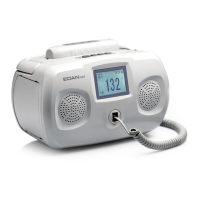SD5/SD6 Ultrasonic TableTop Doppler User Manual Ultrasound Intensity and Safety
- 40 -
MI = P
r, α
f
awf
× C
MI
C
MI
= 1 (MPa / MHz )
A3.3.2 TI (Thermal Index)
Heating of tissues is caused by absorption of ultrasound when the ultrasound energy is applied.
The temperature rise is determined by the acoustic intensity, exposed area and thermophysical
properties of the tissue.
In order to indicate the potential for temperature rise caused by thermal effects, the AIUM and
NEMA formulate thermal index (TI). It is defined as the ratio of the total acoustic power to the
acoustic power required to raise the tissue temperature by 1ºC.
According to different thermophysical properties of the tissue, TI is divided into three kinds: TIS,
TIB and TIC.
TIS (Soft Tissue Thermal Index): It provides an estimate of potential temperature rise in soft or
similar tissues.
TIB (Bone Thermal Index): It provides an estimate of potential temperature rise when the
ultrasound beam passes through soft tissue and a focal region is in the immediate vicinity of
bone.
TIC (Cranial Bone Thermal Index): It provides an estimate of potential temperature rise in the
cranial bones or superficial bones.
A3.3.3 Measurement Uncertainties
The uncertainties in the measurements were predominantly systematic in origin; the random
uncertainties were negligible in comparison. The overall systematic uncertainties were
determined as follows:
1. Hydrophone Sensitivity: ± 23 percent for intensity, ± 11.5 percent for pressure. Based on
the hydrophone calibration report by ONDA. The uncertainty was determined within ±1dB
in frequency range 1-15MHz.
2. Digitizer: ±3 percent for intensity. ± 1.5 percent for pressure.
Based on the stated accuracy of the 8-bit resolution of the Agilent DSO6012 Digital
Oscilloscope and the signal-to-noise ratio of the measurement.
3. Temperature: ± 1 percent
Based on the temperature variation of the water bath of ± 1 ºC.
4. Spatial Averaging: ± 10 percent for intensity, ± 5 percent for pressure.
5. Non-linear Distortion: N/A.
No effects of nonlinear propagation were observed.
Since all the above error sources are independent, they may be added on an RMS basis, giving a
total uncertainty of ± 25.1 percent for all intensity values reported, ± 12.7 percent for all the
pressure values and ± 12.6 percent for the Mechanical Index.
A3.4 Prudent Use Statement
Although no confirmed bioeffects on patients caused by exposure from present diagnostic

